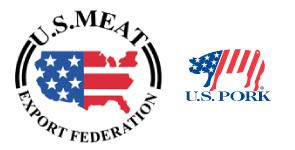Nutrition Facts
Nutrition facts Pork
Today’s Pork Leaner Than Ever
A study released in 2006 by the USDA reveals six common cuts of fresh pork are leaner today than they were fifteen years ago – on average about 16 percent lower in total fat and 27 percent lower in saturated fat.
What’s more, pork tenderloin is now as lean as skinless chicken breast. The study found a 3-ounce serving of pork tenderloin contains only 2.98 grams of fat, whereas a 3-ounce serving of skinless chicken breast contains 3.03 grams of fat.
According to the American Institute of Cancer Research (AICR)/World Cancer Research Fund (WCRF):
Is there any correlation between pork and cancer?
The published data does not substantiate a link between pork and colorectal cancer. Many studies show obesity and the lack of physical activity are conclusive links to many forms of cancer. In fact, there is no significant difference in the mortality rate from colorectal cancer in vegetarians compared to people who eat meat.

Do nitrites in processed meats have any link to cancer?
There are no studies that show a causal link between processed meats and cancer. Nitrite formation is not unique to processed meat. In fact, 95% of nitrates (a precursor to nitrites) come from vegetables and our own saliva. Nitrite is a safe compound approved by the U.S. Department of Agriculture (USDA) for the important purpose of food safety.
- Iron: Getting enough iron is a problem for some women, especially women of child-bearing age. Heme iron (found in meat) is absorbed more readily than nonheme iron (found in plant-based foods). Thus, anyone who avoids meat without the help of their health professional may increase their risk of iron-deficiency anemia.
- Magnesium: Important for the normal function of many enzymes (catalysts for the body’s chemical reactors), glucose and muscle action.
- Phosphorous: Strengthens bones and generates energy in cells.
- Potasium: This mineral, also known as an electrolyte, plays a major role in water balance and helps maintain normal blood pressure.
- Zinc: A component of more than 70 enzymes, zinc is a key player in energy metabolism and the immune system.
- Thiamin: Without this key vitamin, metabolism of carbohydrate, protein and fat would be significantly compromised. Animal protein is one of the best sources of this nutrient, and among the choices, pork is tops.
- Riboflavin: Next to milk, there are few foods that have as much riboflavin per serving as pork. Riboflavin has an important role in the release of energy from foods.
- Niacin: Important for the normal function of many enzymes in the body and involved in the metabolism of sugars and fatty acids.
- Vitamin B12: Helps build red blood cells and metabolize carbohydrates and fats.
- Vitamin B6: Important for the normal function of enzymes and co-enzymes, which are needed to metabolize protein, carbohydrates and fats.
| Lean Cuts | Calories | Total Fat (g) | Satured Fat (g) | Cholesterol (mg) |
|---|---|---|---|---|
| Pork tenderloin | 120 | 3,0 | 1,0 | 62 |
| Pork boneless top loin chop | 173 | 5,2 | 1,8 | 61 |
| Pork top loin roast | 147 | 5,3 | 1,6 | 68 |
| Pork center loin chop | 153 | 6,2 | 1,8 | 72 |
| Pork sirloin roast | 173 | 8,0 | 2,4 | 76 |
| Pork rib chop | 158 | 7,1 | 2,2 | 56 |
